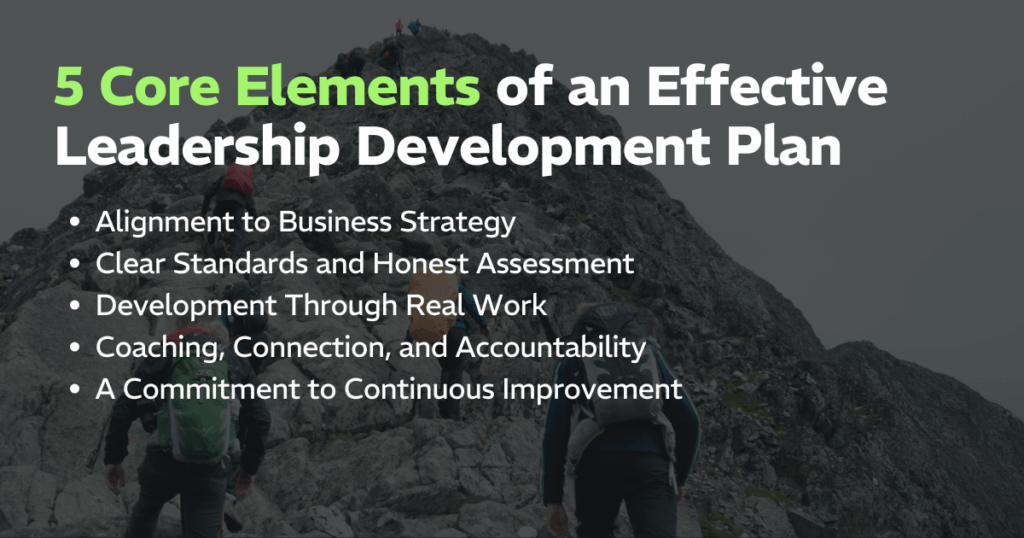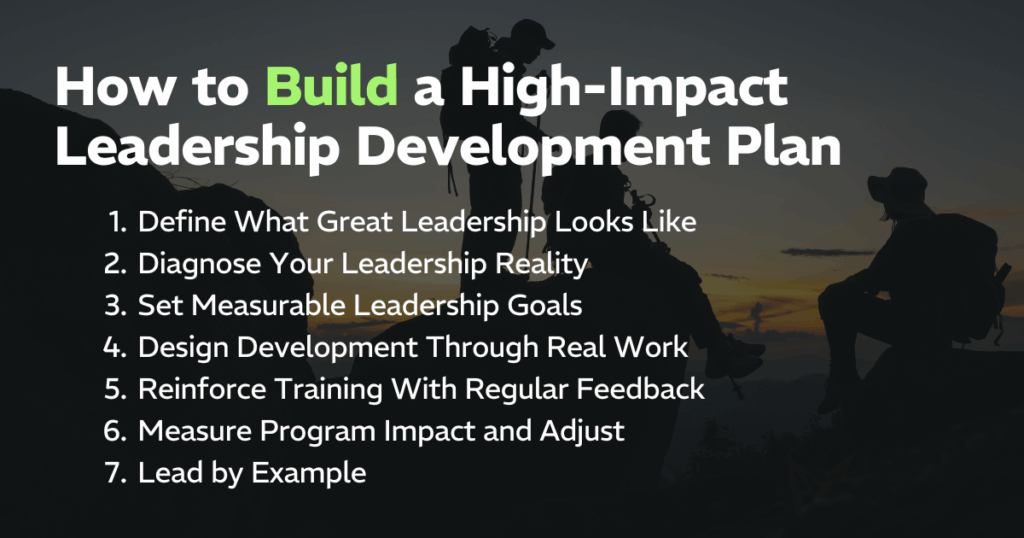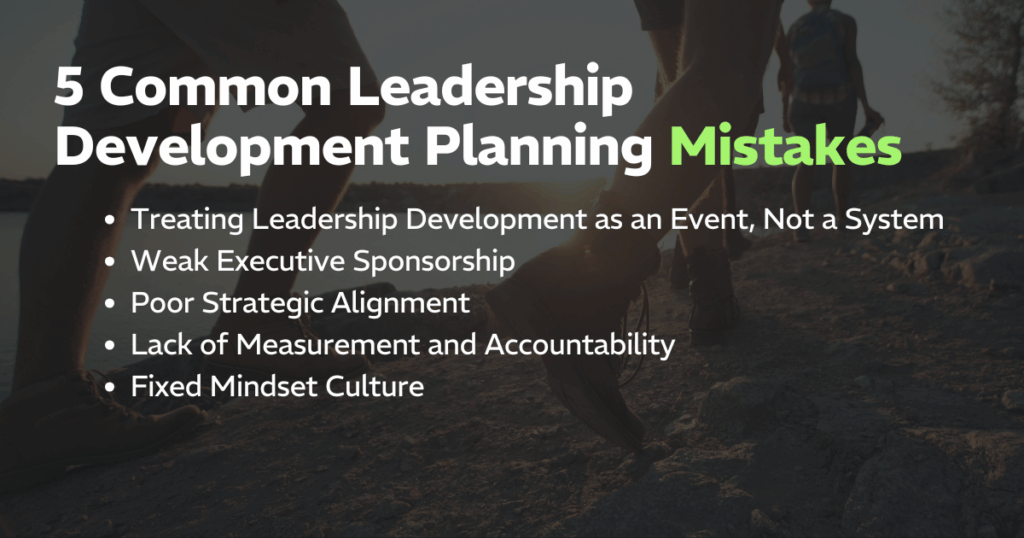Every business outcome —innovation, expansion, sustainability — rises and falls on leadership. Yet many organizations still approach leadership development planning as a series of compliance exercises instead of a system that drives capability and results.
We know that companies that invest in structured, measurable leadership systems outperform peers in profitability, engagement, and agility. Those that don’t often pay the price in turnover, lagging performance, and leadership gaps that slow progress.
Great leadership doesn’t happen by accident. It happens by design, through a plan that connects business and individual goals.
What Is a Leadership Development Plan?
A leadership development plan is the roadmap for how leaders grow and how that growth connects directly to business performance. It defines what great leadership looks like inside your organization, clarifies strengths and gaps, and outlines the actions, feedback, and support needed to close them.
A well-built plan becomes a structured, measurable system for building leadership capacity — the skills, mindset, and behaviors that drive results through people.
At the enterprise level, leadership development planning aligns personal growth with organizational strategy. It creates consistency across teams, ensuring every leader is developing in ways that strengthen both performance and culture. It’s how organizations turn leadership growth into business advantage.
Personal Leadership Development Plan vs. Organizational Leadership Development Planning
Strong organizations are built on leaders who take responsibility for their own growth.
A personal leadership development plan creates that accountability. It’s a simple, written roadmap outlining the priorities, metrics, and actions that move an individual leader forward. Leaders who approach growth this way build trust, accelerate learning, and set the tone for others.
But personal accountability only scales when it’s supported by organizational design. That’s where enterprise leadership development planning comes in.
Company-wide leadership development programs define shared competencies, aligns growth to strategy, and embeds leadership development into the rhythm of work. When the two connect — individual ownership backed by organizational systems — leadership competency becomes a force multiplier.
Leadership Development Plan vs. Performance Review
A performance review measures results already achieved. A leadership development plan builds the capacity to achieve more.
Performance management and leadership development work best when they’re interconnected. When progress, feedback, and growth are part of the same conversation, leaders learn faster, teams perform better, and the organization adapts more quickly.
That’s how reflection becomes momentum and momentum becomes results.
Why Every Organization Needs Leadership Development Plans
Leadership gaps remain one of the biggest barriers to innovation and growth.
The demands on leaders have evolved. Emotional intelligence, adaptability, coaching skill, and change leadership are now non-negotiable. Those capabilities don’t appear naturally; they’re built through structure, feedback, and deliberate practice.
A leadership development plan provides that structure. It’s the system that equips leaders to navigate uncertainty, deliver consistent performance, and build resilient teams.
Execution and Agility
When leadership development goals set reflect enterprise priorities, leaders are better equipped to execute strategy, pivot quickly, and sustain performance during change.
Engagement and Retention
Leaders who know how to coach, listen, and connect create engagement and belonging. Intentional development reinforces those skills and strengthens the employee experience, leading to lower turnover and higher productivity.
Succession and Continuity Planning
Leadership development planning ensures the next generation is ready. It stabilizes transitions, protects institutional knowledge, and strengthens stakeholder confidence in the organization’s long-term capability.
A Healthy Culture of Inclusion
Leadership behaviors shape culture every day. Plans that emphasize empathy, listening, and inclusion build trust and collaboration across teams, which are the foundation for innovation and sustained performance.
5 Core Elements of an Effective Leadership Development Plan
An effective enterprise leadership development plan connects business strategy to human potential for all leadership roles. Here are five core elements in every plan.
Alignment to Business Strategy
When development and strategy move together, performance accelerates. Define the outcomes leadership must deliver, such as growth, innovation, efficiency, or transformation, and design achievable goals around them.
Clear Standards and Honest Assessment
Honest assessment builds the foundation for focused, measurable improvement. Growth starts with clarity. Define what great leadership looks like in your organization and measure against it. Use 360 feedback, engagement insights, and performance data to understand where your team members stand and where the biggest skill gaps exist.
Development Through Real Work
Real work creates confidence and capability that no classroom alone can replicate. The best learning happens on the job. Stretch assignments, cross-functional projects, and transformation initiatives push leaders beyond comfort zones and into growth.
Coaching, Connection, and Accountability
Leadership growth takes feedback and reinforcement. Coaching builds awareness. Mentorship transfers wisdom. Peer learning creates community. When these supports are built into the system, development activities foster a culture.
A Commitment to Continuous Improvement
Continuous improvement keeps leadership development plans relevant, agile, and built for what’s next. The best organizations never stop refining how they build leaders. They track progress, listen to feedback, and adapt as strategy and workforce needs evolve.

How to Build a High-Impact Leadership Development Plan
The difference between a training program and a leadership transformation isn’t content. It’s commitment.
1. Define What Great Leadership Looks Like
Translate strategy into behavior. Define the mindsets and skills required to execute your business plan today and in the future. This becomes your leadership success profile, the standard every leader can grow toward.
2. Diagnose Your Leadership Reality
Start with data, not assumptions. Combine assessments, engagement analytics, and qualitative feedback to understand how leadership styles and behaviors are driving or limiting performance. Identify patterns across levels and teams. The insight will tell you where to invest first.
3. Set Measurable Leadership Goals
Turn expectations into measurable outcomes. At the enterprise level, set two to three SMART goals tied to strategy:
- Improve leadership effectiveness scores by 15% year over year.
- Increase internal promotion rates for critical roles.
- Raise engagement or trust scores by 10 points.
At the individual level, leaders should set one or two career goals aligned to those outcomes. When accountability becomes cultural, performance follows.
4. Design Development Through Real Work
Integrate learning into live challenges in real business environments: transformation projects, customer initiatives, and innovation sprints. A blended model (70% experience, 20% coaching, 10% formal training) keeps learning practical and performance-linked.
5. Reinforce Training With Regular Feedback
Formal professional development without reinforcement fades fast. Establish structured feedback loops, such as quarterly reviews, coaching sessions, peer reflection forums, that make growth visible and measurable.
When leadership discussions become part of daily performance, development becomes a habit.
6. Measure Program Impact and Adjust
Treat leadership development like a business investment. Track hard metrics — retention, engagement, productivity, customer outcomes, profitability — alongside qualitative insights like employee stories and observed behaviors. Review results quarterly and refine your plan. Continuous improvement keeps development relevant and high-impact.
7. Lead by Example
Leaders go first. When executives model growth — teaching, mentoring, and learning themselves — they set the tone for everyone else.

5 Common Leadership Development Planning Mistakes (and How to Avoid Them)
Designing a leadership development plan is only half the work. Sustaining it is what separates organizations that transform from those that stall. Here are the most common pitfalls and how to avoid them.
- Treating Leadership Development as an Event, Not a System. One-off training doesn’t change behavior. Lasting capability comes from systems that reinforce learning over time.
- Weak Executive Sponsorship. When senior leaders don’t model growth, no one else will. Visible engagement from the top makes development a business priority.
- Poor Strategic Alignment. Programs that aren’t tied to strategy lose focus fast. Anchor leadership development to measurable business outcomes to sustain momentum.
- Lack of Measurement and Accountability. Track what matters — retention, engagement, productivity — and share progress. Transparency drives improvement.
- Fixed Mindset Culture. Future leaders grow when they can be honest. Model vulnerability, invite feedback, and make it safe to learn in public.

Individual Development Plan Examples for Leadership
You don’t need special software to start working on your own leadership development. Use this simple leadership development plan template to capture goals, measures, and momentum.
Header
Name | Role | Date | Manager/Mentor
1) Self-Assessment Snapshot
Top strengths (evidence) | Priority gaps (evidence) | 360 themes
2) Three Development Goals (with measures)
- Goal #1 → Metric(s) → Why it matters
- Goal #2 → Metric(s) → Why it matters
- Goal #3 → Metric(s) → Why it matters
3) 90-Day Action Plan
Learning (what/when) | Doing (project/owner/due) | Coaching (cadence) | Support/resources
4) Cadence
1:1s | Mentor | Peer circle | Reflection ritual (weekly)
5) Milestones & Evidence of Impact
Checkpoints | Business outcomes | Human outcomes (stories + scores)
6) Adjustments & Next Cycle
What we’ll change | New bets | Risks/needs
Leadership Development Plan Examples
If you need inspiration for “what” to build using this leadership development plan template, consider:
- Communication mastery: Run public speaking reps, active listening practice, and feedback drills that strengthen clarity and connection.
- Inclusive leadership: Mentor diverse talent and build rituals that amplify every voice and perspective.
- Innovative problem-solving: Lead design thinking sprints and experiment portfolios that turn ideas into outcomes.
- Change leadership: Guide transitions with empathy; coach teams through uncertainty and ambiguity.
- Strategic vision: Co-create a two-year roadmap with your team that links purpose to performance.
- Sales leadership: Coach through live deal reviews and customer conversations that focus on creating value, not just closing.
Pick one or two that directly support your team’s goals. Don’t try to fix everything at once.
Make Leadership a Daily Practice
Leadership skill development sticks when it moves off the slide deck and onto your calendar. Here’s how to build that rhythm into your routine:
- Run a monthly listening tour. Give employees a voice and act on what you hear.
- Build mentorship programs that prioritizes growth and well-being.
- Start recognition rituals in team meetings. Celebrate effort and impact in real time.
- Reflect weekly. Who did I help grow? How did I make work better?
Your Move: Put Leadership Development Into Action
If you’re serious about growing your leadership capabilities at scale, invest in a plan that blends human outcomes with hard results. Build leaders on purpose. And if you want a fast start, bring your team together to clarify the vision, calibrate the plan, and get the first actions on the calendar.
Elevate leadership across your organization. Book Ryan Estis’ Human-Centered Leadership keynote inspire and equip your leaders with the mindset and skills to lead with impact.



![[RYAN] Featured_Leadership Development Planning for Human Centered Growth Group climbing a hill together](https://ryanestis.com/wp-content/uploads/bb-plugin/cache/RYAN-Featured_Leadership-Development-Planning-for-Human-Centered-Growth-1024x538-panorama-ba61edeb5d6c961b544c5c7916ed5ca0-.png)






